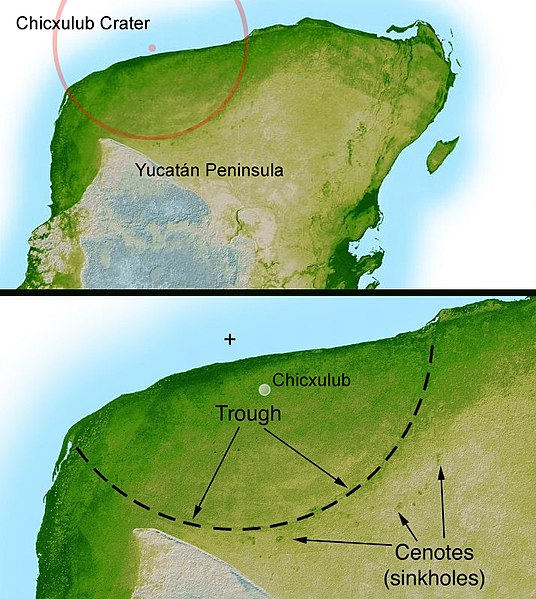Unfortunately, a school group of 13-year-olds had the theatre booked to see a movie on volcanoes instead. Fortunately, it was actually a really amazing movie. After that, I watched the movie I planned on. It was also great.
Let me share with you some of the amazing things I learned.
The giant meteorite thought to have caused the extinction of the dinosaurs is not visible directly. It's on the tip of the Yucatan peninsula in Mexico. However, the outer rim of the crater is marked by cenotes, or sink holes... holes in the ground leading to elaborate caves filled with water.

Another amazing meteorite crater can be seen in Arizona.
View Larger Map
The movie on volcanoes had an excellent demonstration of plate tectonics. It showed a time-lapse movie of a lava lake in the Erta Ale volcano in Ethiopia, similar to this video,
I thought that was a really vivid illustration, especially since continents moving over millions of years is pretty hard to grasp intuitively.
Speaking of land moving, the movie also mentioned that some mountains grew about 5 metres after a single earthquake.
I was taken aback when "The Power of the Planet" movie went on and on about how special the earth is. Just the right distance from the sun, with just the right mass, and atmospheric CO2, etc. It was starting to sound like a privileged planet argument that you would get from Intelligent Design proponents. But in the end they were simply making the case that our (human) influence on the planet can disturb the balance and render earth unliveable. The take-home message: earth will survive a long time, but we might not. I think that's an important message.
Another interesting factoid I hadn't realized; about 700-million years ago, the earth was covered by ice and snow. They call it the "snowball earth".
I got to touch a rock that is about 3.8 billions years old. Newfoundland and Labrador is made up of multiple patches of earth plates, with dates of rocks ranging in age from 450 million years to 3.8 billion years. The rocks around St. John's are about 450 million years old... just babies. But that's old when you consider that the Rocky Mountains were formed a mere 100 to 200 millions years ago.

Iceland sits atop a huge plume of magma that protrudes up through the earth's mantle. It's right where two major plates meet. Iceland probably formed from an underwater volcano.
The centre also had a nice section on human evolution. I especially like their coverage of cultural evolution, "Speech and language gave rise to counting, writing, ... and much else that forms the foundation of culture, including art, music and religion."

No comments:
Post a Comment